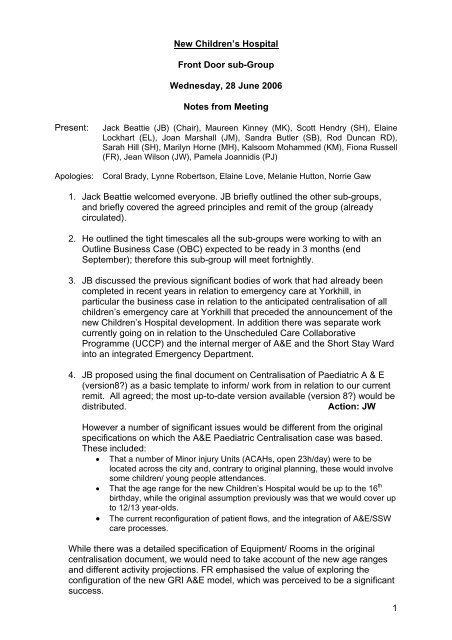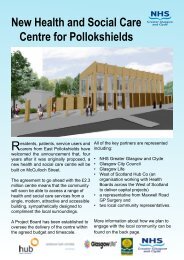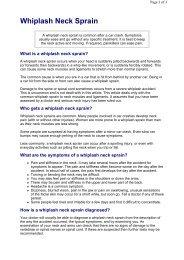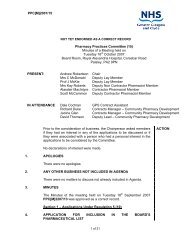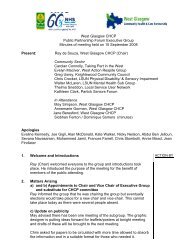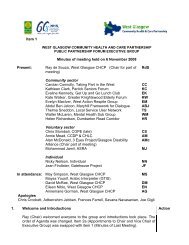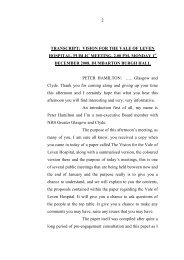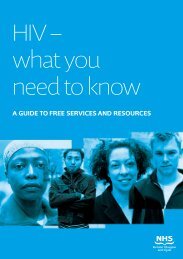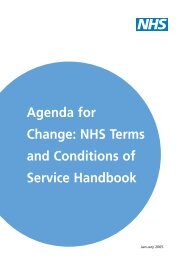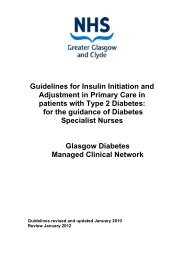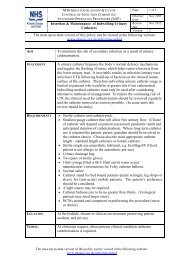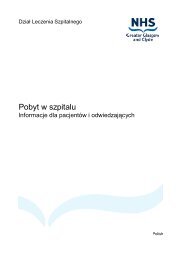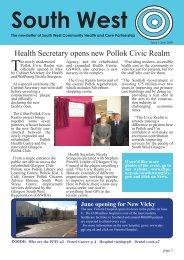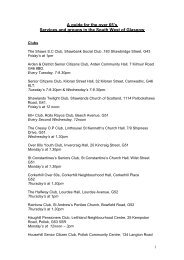28/06/2006 - NHS Greater Glasgow and Clyde
28/06/2006 - NHS Greater Glasgow and Clyde
28/06/2006 - NHS Greater Glasgow and Clyde
Create successful ePaper yourself
Turn your PDF publications into a flip-book with our unique Google optimized e-Paper software.
New Children’s Hospital<br />
Front Door sub-Group<br />
Wednesday, <strong>28</strong> June 20<strong>06</strong><br />
Notes from Meeting<br />
Present: Jack Beattie (JB) (Chair), Maureen Kinney (MK), Scott Hendry (SH), Elaine<br />
Lockhart (EL), Joan Marshall (JM), S<strong>and</strong>ra Butler (SB), Rod Duncan RD),<br />
Sarah Hill (SH), Marilyn Horne (MH), Kalsoom Mohammed (KM), Fiona Russell<br />
(FR), Jean Wilson (JW), Pamela Joannidis (PJ)<br />
Apologies: Coral Brady, Lynne Robertson, Elaine Love, Melanie Hutton, Norrie Gaw<br />
1. Jack Beattie welcomed everyone. JB briefly outlined the other sub-groups,<br />
<strong>and</strong> briefly covered the agreed principles <strong>and</strong> remit of the group (already<br />
circulated).<br />
2. He outlined the tight timescales all the sub-groups were working to with an<br />
Outline Business Case (OBC) expected to be ready in 3 months (end<br />
September); therefore this sub-group will meet fortnightly.<br />
3. JB discussed the previous significant bodies of work that had already been<br />
completed in recent years in relation to emergency care at Yorkhill, in<br />
particular the business case in relation to the anticipated centralisation of all<br />
children’s emergency care at Yorkhill that preceded the announcement of the<br />
new Children’s Hospital development. In addition there was separate work<br />
currently going on in relation to the Unscheduled Care Collaborative<br />
Programme (UCCP) <strong>and</strong> the internal merger of A&E <strong>and</strong> the Short Stay Ward<br />
into an integrated Emergency Department.<br />
4. JB proposed using the final document on Centralisation of Paediatric A & E<br />
(version8?) as a basic template to inform/ work from in relation to our current<br />
remit. All agreed; the most up-to-date version available (version 8?) would be<br />
distributed. Action: JW<br />
However a number of significant issues would be different from the original<br />
specifications on which the A&E Paediatric Centralisation case was based.<br />
These included:<br />
• That a number of Minor injury Units (ACAHs, open 23h/day) were to be<br />
located across the city <strong>and</strong>, contrary to original planning, these would involve<br />
some children/ young people attendances.<br />
• That the age range for the new Children’s Hospital would be up to the 16 th<br />
birthday, while the original assumption previously was that we would cover up<br />
to 12/13 year-olds.<br />
• The current reconfiguration of patient flows, <strong>and</strong> the integration of A&E/SSW<br />
care processes.<br />
While there was a detailed specification of Equipment/ Rooms in the original<br />
centralisation document, we would need to take account of the new age ranges<br />
<strong>and</strong> different activity projections. FR emphasised the value of exploring the<br />
configuration of the new GRI A&E model, which was perceived to be a significant<br />
success.<br />
1
5. Activity projections <strong>and</strong> dem<strong>and</strong> modelling.<br />
The most important issue for the group would be to accurately predict future<br />
activity. Only then could rational planning <strong>and</strong> a secure OBC be developed.<br />
There would need to be robust data, at a minimum within of 90% correct<br />
figures for secure projection. We will split age groups <strong>and</strong> look at under 1 year<br />
old; 1-5; 5-12;13-16 years old.<br />
The current concept of the remodelling of the Emergency Department patient<br />
journey would also have to be considered, with the planned patient flows of<br />
Resuscitation, Assessment, Minor Injury <strong>and</strong> Extended Observation likely to<br />
impact on any departmental configuration.<br />
FR noted that some work had already been completed reviewing the patient<br />
journey from arrival to discharge/admittance <strong>and</strong> time taken. This could be<br />
extended.<br />
External activity data was unsound at best. SMR 1’s from all areas would<br />
need to be checked, but if patient is not admitted there is no coding/SMR1<br />
data. Also need to check the Dataset of minors/majors.<br />
Orthopaedics (RD). Projecting fracture clinic numbers is very insecure, since<br />
they are not recorded in an age-stratified manner anywhere. The elective<br />
clinic numbers are going to be easier to predict. It is likely that Stobhill <strong>and</strong><br />
Victoria ACADs will send all under 16s with fractures to the new RHSC,<br />
whether or not they need I/P treatment. GRI’s approach is very uncertain.<br />
Conceivably, we may have to deal with all fractures in individuals less than 16<br />
yrs in <strong>Glasgow</strong> (? + Paisley). This is significantly more than predicted in the<br />
centralisation document (details to be checked). Action: RD<br />
CHKS (a major UK independent provider of comparative information analysis<br />
<strong>and</strong> benchmarking services to the <strong>NHS</strong> had been invited to support work of all<br />
the groups. However it was acknowledged that finding appropriate<br />
benchmarking comparators was difficult.<br />
6. The “Paisley issue”. JB advised the group that there were no formal plans<br />
to consider the downgrading of the RAH paediatric Activity by <strong>NHS</strong> GG &<br />
<strong>Clyde</strong>, but the general professional view was that the close geographical<br />
association of the new Children’s Hospital to the Paisley area would inevitably<br />
mean that there would be significant drift of acute clinical activity to the New<br />
Children’s Hospital from that area with relocation. However this was a highly<br />
sensitive issue politically, <strong>and</strong> there was no official Health Board<br />
acknowledgement of this. It was conceivable that in due course the in-patient<br />
general paediatric facility at the RAH would close, with their activity becoming<br />
subsumed with the new hospital.<br />
While this could not be formally discussed, the issue posed a significant risk<br />
to activity that it could not be ignored. Our activity modelling would have to<br />
consider this issue, whether or not the origins of the patients was to be<br />
explicitly acknowledged.<br />
If this were to happen it would mean more space would need to be planned<br />
for <strong>and</strong> current RAH paediatric activity would need to be confirmed. Approx 6-<br />
7k patients attend RAH at present but it is not known what percentage are<br />
medical admissions. FR would explore children/young people activity levels<br />
with colleague(s) at the RAH A&E department. Action: FR<br />
Similarly, it was uncertain what impact might occur with the announced<br />
downgrading of the Monkl<strong>and</strong>s A&E; some families may prefer to take their<br />
children to New Children’s hospital rather than Wishaw?<br />
2
7. Projected adolescent activity (13-15 year-olds)<br />
The Group will need to get profile of this additional patient dem<strong>and</strong>: numbers;<br />
admissions; specific clinical problems such as trauma, Mental Health (self harm)<br />
<strong>and</strong>/or OBS/Gynae problems?<br />
It would be useful to explore Alder Hey (Liverpool) figures for 13-16 year olds, as<br />
they have similar population. Jean Wilson will explore this with contacts there. We<br />
also need to look at local <strong>Glasgow</strong> figures, if possible. Action: JW<br />
There was a general underst<strong>and</strong>ing that there was already a significant number of<br />
adolescents currently cared for by a variety of (tertiary) specialties at Yorkhill; it was<br />
unclear if this would actually change significantly. We would need to be aware of this<br />
issue, <strong>and</strong> link with the other subgroup projections to let us assess any potential<br />
impact on Front Door activity.<br />
There were a number of specific Adolescent issues to clarify:<br />
• Adolescents – Adults shared services <strong>and</strong> transitional care arrangements.<br />
How would this work? Check the Nottingham arrangements.<br />
• Chronic illness Discuss with Jim Beattie Action JB<br />
• Teenage Cancer Currently up to 18yrs<br />
• It was recognised that there would need to be a separate area for adolescents<br />
for Mental Health assessments. This would include a safe interview room.<br />
Elaine Lockhart will look at figures for adolescent attendees at present.<br />
Action: EL; Dougie Fraser<br />
• Gynaecology – numbers/ projections? How this would link to the Specialist<br />
Suite at S<strong>and</strong>yford. What happens at Alder Hey?<br />
Action: Sarah Hill<br />
8. Adjacency <strong>and</strong> interface issues.<br />
The Group discussed a number of topics. FR had attended a meeting in relation<br />
to the general “footprint” of the new hospitals development. This primarily related<br />
to high-level adjacency arrangements of the different individual components of<br />
the campus. It was perceived that the New Children’s hospital would be<br />
effectively a st<strong>and</strong>alone facility, but with appropriate links to the Maternity Unit,<br />
<strong>and</strong> a common ambulance route to paired but separate Adult <strong>and</strong> Paediatric<br />
Emergency Department entrances.<br />
A variety of specific internal adjacencies were proposed:<br />
• It was recognised that in particular there was a need for PICU <strong>and</strong> urgent imaging<br />
services to be close to the Emergency Department. CT must be adjacent to the ED,<br />
with a dedicated CT for children <strong>and</strong> young people. (There may be a link corridor to<br />
adult services for limited overflow use).<br />
• Other imaging (US/X-Ray) must be close by, <strong>and</strong> probably have dedicated satellite<br />
unit within the ED.<br />
• A (combined) trauma/medical/surgical extended observation ward would be part of<br />
the Emergency Department development<br />
• PICU should be close by e.g. next level with direct lift; also linked to Theatres.<br />
• It was likely that further functional associations would continue to blur the traditional<br />
Surgical/Medical labels of services (e.g. an integrated gastroenterology service), <strong>and</strong><br />
these services would primarily be tertiary in nature.<br />
3
• There was a need for close association of the ED with remaining secondary level<br />
inpatient Medical/Surgical ward(s). Acute receiving will be multifunctional with<br />
children being transferred there or to specialist wards as happens at present.<br />
• Hospital at Night team - This should be based within the ED, (dedicated<br />
rooms?), to maximise communication <strong>and</strong> h<strong>and</strong>over arrangements. The acute<br />
receiving team & Hospital at Night could share accommodation, with direct<br />
access from department via lift. An anticipated configuration would be ground<br />
floor ED, PICU on first floor, <strong>and</strong> secondary care inpatient wards on second floor.<br />
• There would be a need for a multifunctional interview room within the ED,<br />
designed appropriately for complex risk cases. Including child protection <strong>and</strong><br />
initial mental health interviews. However it was clear that adolescent self-harm<br />
patients would have to be accommodated within any dedicated adolescent facility<br />
<strong>and</strong> not in the ED.<br />
• Child protection. We would need clarity where acute assessments take place.<br />
SH noted that numbers were relatively small <strong>and</strong> that most children have elective<br />
examinations. There was a need to clarify what aspects of the current child<br />
protection activity the S<strong>and</strong>yford assessment centre will be picking up.<br />
Action: SH<br />
Laboratories – will apparently be located remotely on the campus, with a<br />
tube system? It was unlikely there would be a dedicated hot paediatric<br />
laboratory; this may have implications for near-patient testing facilities, <strong>and</strong><br />
implies that the ED may have to have a small in-house laboratory area for<br />
gases etc.<br />
We need to link with the Imaging/Laboratories group to clarify this.<br />
Ophthalmology – It was understood that this would be based at the<br />
Gartnavel site. We would need to be clear how this would impact on the<br />
need for specific equipment/ accommodation within the ED.<br />
Neurosciences – It was unclear at present where this service would be<br />
based, but it was likely to be a centralised service. It was not clear if<br />
children <strong>and</strong> young people would be cared for within the SGH<br />
neurosciences complex, or within the new children’s hospital.<br />
9 IT<br />
Plans were not known but appropriate investment in Information Technology<br />
would be an essential component of the department’s future success <strong>and</strong><br />
UCCP compliance. It was essential to introduce the nationally recommended<br />
Emergency Department Information System (EDIS), <strong>and</strong> not to continue with<br />
Meditech. The Meditech A&E module was known to be poor, while EDIS was<br />
established to have dramatically improved ED patient flows in Engl<strong>and</strong>. It<br />
allows organisation of care more efficiently, thereby providing a more patientcentred<br />
service, <strong>and</strong> maximise the opportunity to ensure that 98% of patients<br />
will be seen, discharged or admitted within 4 hours.<br />
Additionally, we would need full implementation of PACS, with an expectation<br />
that we would be a ‘film-less’ department on opening.<br />
Access to Telemedicine facilities was important. While the use of such<br />
techniques in remote acute consultation was uncertain, there was a perceived<br />
need from external clinicians in other areas (Western Isles) to use such<br />
techniques to discuss cases, <strong>and</strong> seek support while awaiting retrievals. It<br />
was already an established educational resource.<br />
4
10. Other issues:<br />
Security would have to be considered. This would involve the use of swipe<br />
card access, panic buttons/ alarms. A functional separation of staff/care<br />
areas would be important, with strict control of public access.<br />
Pharmacy - This would have to be clarified. The group were uncertain<br />
whether there would be a dedicated children’s pharmacy <strong>and</strong> an OPD<br />
pharmacy on site, but the group felt strongly that a dedicated paediatric<br />
pharmacy would be a useful resource. This should include electronic<br />
prescribing, including a weekend service.<br />
11. It was recognised that well-founded projected activity patterns for specific age<br />
groups would be the cornerstone of sound project planning <strong>and</strong> this would be<br />
the group’s priority meantime. There were already available DOH validated<br />
design templates for EDs, including Children’s EDs (SH).<br />
However it would also be useful for all group members to consider the<br />
previous centralisation document that JW would supply, to allow a baseline for<br />
further discussion. Action: All<br />
Date of next meeting – Friday 14 July in QMH Classroom 1000-1200.<br />
5


